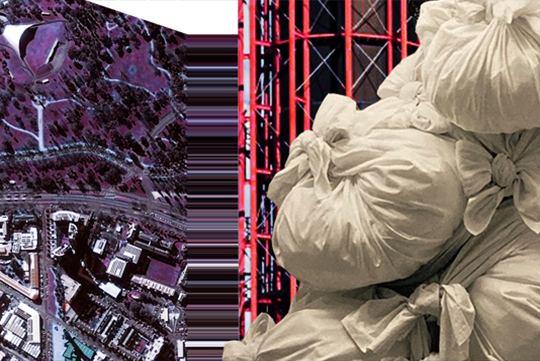Studio 06
Forms of Enchantment
Heather Mitcheltree and Mitchell Ransome

Studio Description
This studio is an exploration of the representation of myth-scapes in contemporary culture, literature, art and architecture. Of the ways in which identity is constructed, projected and framed, and of the mechanisms by which we make sense of a world that is often stranger than fiction. From the nostalgic meanderings of Swann’s Way, Utopian visions, Hieronymus Bosch’s macabre allegorical landscapes, to tales of gingerbread houses and Homer’s depiction of Odysseus’ travels - speculative geographies and fabrications that blur the boundaries between fact, fantasy and fiction continue to capture our imagination.
These enchanted imaginings, take us on a journey through metaphorical transformations, spatial articulations of memory and time, the unheimlich, aspirational visions, and the dark shadows that linger in the recesses of our imaginations and infiltrate our day to day. Through a series of installations and the design of a Creative Arts Centre, this studio serves as a creative exploration of the constructs that we create, and the role that they play in “reaching beyond the visible and transforming a rich inner life into uncanny, sometimes disturbing matter” (Warner, M., 2018).
Studio Outcomes
Within this studio students will undertake:
- Fact, fantasy and fiction: In the first stage, students are asked to explore mythical constructs and fantastical imaginings in art, literature, film, and architecture. Paired with a selected contemporary political issue, students will explore the ways in which these enchanted imaginings, and utopian visions provide insight into socio-political constructs, and the human psyche.
- Into the looking glass: Through interdisciplinary practice students will be asked to re-imagine and question ideas of place making, identity and how art and design can begin to evoke a human response. Based on their research, students will develop a speculative proposition that questions traditional boundaries and explores contemporary socio-political conditions, and fantastical fabrications.
- The Urban Imaginarium: During this phase students will develop design strategies to navigate complex socio-spatial conditions of fantasy, surreal landscapes, the dark recesses of our imaginations, and the politics of the everyday.
Studio Leaders
Heather Mitcheltree
Heather currently teaches design at the Melbourne School of Design. Having worked for over 15 years at the University of Melbourne across a range of teaching and research roles, Heather has a broad interdisciplinary research background. Heather’s work focuses primarily on trauma-scapes, and interdisciplinary approaches to understanding and representing complex socio-spatial narratives and the psychological impact of the built environment. Heather’s practice lies at the margins of art, architecture, research, and theory, and in addition to research and teaching, she engages in private design work, art practice, creative design and art collaborations, and research consultation. Heather is currently a PhD candidate at the University of Cambridge.
Mitchell Ransome
Mitchell currently teaches design and works in the Digital Fabrication Workshop at the Melbourne School of Design. He has an in-depth knowledge of experimental fabrication techniques in architecture, furniture design, model making, materiality and detailing. Through his work Mitchell has developed a strong base across a wide variety of digital skills, such as 3 and 4 axis fabrication, sheet forming, 3D scanning and digital manipulation. Mitchell’s private work focuses on photography and the dislocation and exile of people and place. He has a recently published a book, ‘The Opposite to Good but not Bad’.
Both individually and collectively, Heather and Mitchell have had their work exhibited at the Museum of Contemporary Art in Sydney, the Melbourne International Fringe festival, the Buffer Fringe Performing Arts Festival 2019 in Cyprus, the Centre for Contemporary Photography 2021 and featured in a range of national and international publications.
Readings & References
- A.Paine, S.Holden and J.Macarthur, (2020). Valuing Architecture: Heritage and the Economics of Culture. Australia, Queensland: The University of Queensland
- Pier Vittorio Aurelli (2011). The Possibility of an Absolute Architecture. USA, MIT Press
- Lebbeus Woods and Clare Jacobson, (2015). Slow Manifesto. USA, Princeton Architecture Press.
- Conrad Harmann, (2012). Cities of Hope Remembered/Rehearsed: Australian Architecture and Stage Design by Edmund and Corrigan 1969 – 2012. Australia, Thames and Hudson
- T. Davidge and J.Gillings, (2020). Valuing the Civic. Landscape Australia, Architecture Australia, Australia Media Pty Ltd
- Susan Holden (2015). Possible Pompidus (pp. 33 – 45). UK, AA Files. Architectural Association.
- E-Flux Journal. https://www.e-flux.com/
Schedule Mondays 18:15-21:15, Thursdays 18:15-21:15